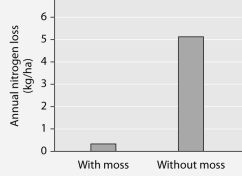Multiple Choice
The next question is based on the following description and Figure 29.1, which is the same as Figure 29.10 in the textbook.
Art Questions
Researchers tested nitrogen loss from soil where the moss Polytrichum was growing, and compared it to soil from which Polytrichum had been removed. The data are presented below.

Figure 29.1
-Loss of soil nitrogen via "gaseous emission" was found to be negligible. Rather, most loss of soil nitrogen was due to water erosion of the soil. Which of these hypotheses is least likely to account for the observed results?
A) If rhizoids had helped stabilize the soil, then less erosion and less loss of nitrogen would occur.
B) If protonemata had absorbed, and stored, nitrogen from the soil, then they would have reduced loss of nitrogen by erosion.
C) If the overlying mat of gametophores had slowed the entry of water into the soil, then it would have reduced water's ability to erode the soil and carry away its nitrogen.
D) If sporophyte stomata had absorbed nitrogen from the soil, then they would have reduced loss of nitrogen by erosion.
Correct Answer:

Verified
Correct Answer:
Verified
Q22: Two small, poorly drained lakes lie close
Q23: Which event during the evolution of land
Q24: At some time during their existence, bryophytes
Q25: Which taxon is essentially equivalent to the
Q26: <img src="https://d2lvgg3v3hfg70.cloudfront.net/TB5463/.jpg" alt=" Figure 29.3
Q28: Which of the following was not a
Q29: Arrange the following terms from most inclusive
Q30: As is true of the gametophytes of
Q31: Refer to the following information to answer
Q32: During glacial periods in the early evolution